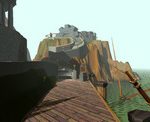first person
Santaman’s Harvest Yields Questions, or Does a Performance Happen if it Exists in a Virtual Forest?

Adriene Jenik describes a project of virtual performances via avatars in online chat spaces.
Communities of Play: The Social Construction of Identity in Persistent Online Game Worlds

Celia Pearce applies the logics of identity politics, diaspora studies, and cultural studies to an online gaming community.
Me, the Other

Torill Elvira Mortensen explains the joys of the role-playing high, in which the player no longer has to contemplate how her character might act in a given situation; instead the player simply reacts as the character. Mortensen develops the case to argue that role-playing experience can lead to a cynicism about the sincerity of people's out-of-character (or real-world) personae.
Eliza Redux

Adrianne Wortzel explains a revisioning of the 1960s computer-based therapist simulator, which moves beyond the original's text-only interface to include graphics, robotics, and an ever-expanding vocabulary.
On Adventures in Mating

Joe Scrimshaw describes his interactive stage drama, which with the exception of the technologies it employs, operates much like the computer-based interactive fiction Facade (discussed elsewhere in this thread). Rather than using code to select the proper reaction to user input as in Facade, the audience of Adventures in Mating votes on the choices the characters make, a la a Choose Your Own Adventure novel.